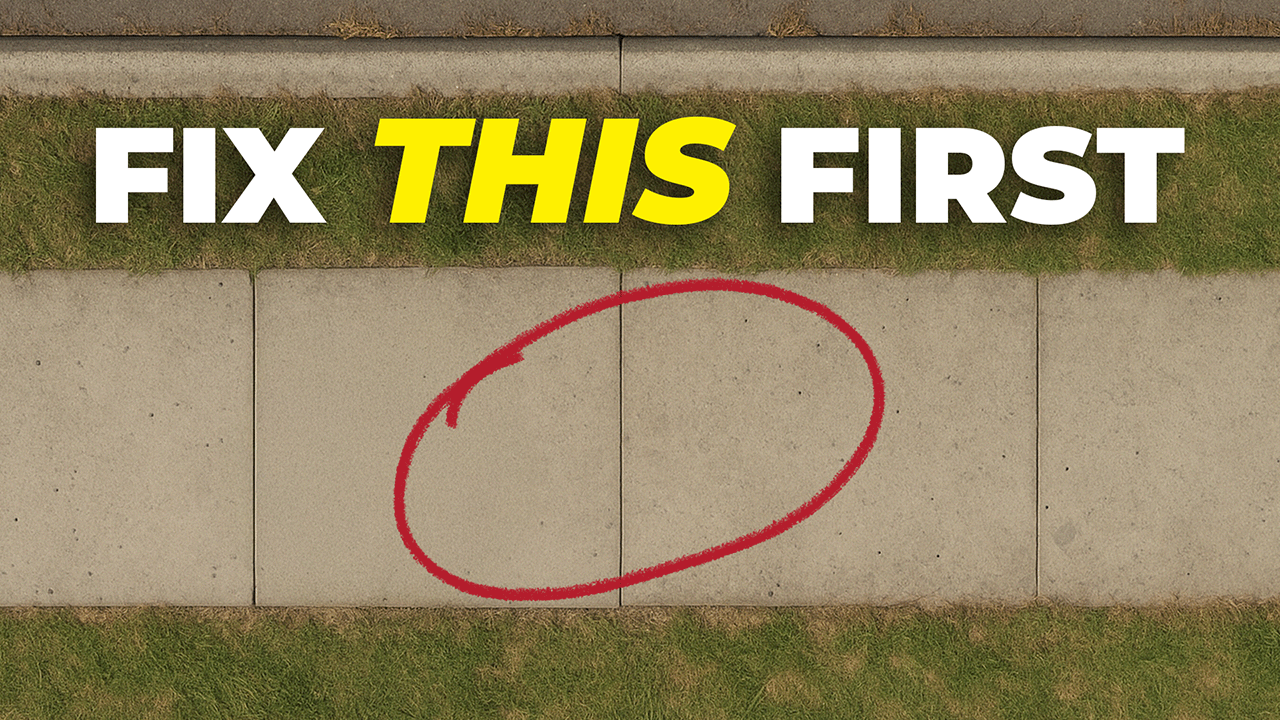Topics:
Search for topics or resources
Enter your search below and hit enter or click the search icon.
Providing your email address will keep you updated should we need to provide updates specific to your location.
June 19th, 2025 | 3 min. read

From driveways and sidewalks to pool decks and patios, uneven concrete isn’t just an eyesore. It’s a safety risk and a liability concern. The good news? You don’t always need to replace the slab. Here are five effective solutions to help restore a safe, level surface.
TL;DR: Your Concrete Repair Options

Concrete leveling, also known as slabjacking, mudjacking, and concrete lifting, raises your existing concrete by injecting a special compound beneath it. At A-1, we use a low-pressure, stone slurry mix that offers precise control and reliable results. This compound fills any voids under the slab, then gently lifts it back into place, hardens, and becomes a durable new base for the slab to rest on.
In general, the concrete leveling process works by drilling small, strategically placed holes through the uneven concrete slabs and pumping a compound beneath the surface.
Pros:
Fast (usually done in under a day)
Long-lasting (often outlives the original slab)
Cost-effective (saves up to 70% vs. replacement)
Cons:
Not suitable for slabs with extensive cracks or crumbling
May not fully correct slabs with extreme heaving from roots or frost
Best For:
Trip hazards
Uneven sidewalks or driveways
Slabs affected by tree roots
Check out the Ultimate Guide to Concrete Leveling Costs in 2025

Grinding concrete removes height differences between slabs, typically using a diamond grinder. It's fast and affordable—but comes with tradeoffs.
Pros:
Quick to perform
Affordable
Good for small height differences
Cons:
Exposes porous concrete
Weakens slab integrity
Creates cosmetic inconsistencies
Typically a one-time solution
Best For:
Temporary fixes
Slabs with extreme root lifting where leveling isn’t viable
Pro Tip: In contrast to other repair methods, grinding can typically only be done once.
Read More: When Is Concrete Grinding the Right Solution?
Patch kits or added layers can temporarily mask dips and gaps, but they’re not permanent solutions.
Application:
Hardware-store patch kits for small cracks
Hand-mixed concrete to build gradual ramps between slabs
Pros:
Inexpensive
Quick DIY fix for small issues
Minimal tools required
Cons:
Prone to chipping and cracking
Doesn’t address underlying causes like voids or settling
Temporary lifespan
Best For:
Quick cosmetic fixes
Filling small gaps until full repair can be scheduled

Self-leveling concrete compounds are ideal for interior concrete floors to prepare for flooring like vinyl, tile, or hardwood.
Pros:
Creates smooth finish for flooring installation
DIY-friendly for interior projects
Cons:
Not suitable for outdoor use
Breaks down when applied too thick
Can crack and fail under exterior conditions
Never Use On:
Exterior slabs
Heavily sunken or structurally compromised concrete
Why?
Outdoor exposure and slab movement cause the material to crack, flake, or fail.
Related Resource: Common Problems With Using Self-Leveling Concrete

Replacement involves demolishing and pouring new concrete. While it offers a clean slate, it’s the most expensive and time-consuming option.
Pros:
Offers a full reset
Can address deep structural issues
Cons:
30-day cure time
Hard to color-match
Risk of resettling
Disruption to surrounding landscaping
Higher costs
Best For:
Slabs beyond repair
Extensive structural damage
Example:
In Columbus, Ohio, a property manager replaced a parking pad section but faced mismatched slabs and tenant complaints—making them wish they’d tried leveling first.
Related Resource: How New Concrete Is Poured
It depends. If you need a quick fix and aren't necessarily concerned with longevity, grinding, patching, or self-leveling may work. If you value cost savings, speed, and long-term reliability, concrete leveling is often the smart choice. If your slab is crumbling or severely broken, replacement may be necessary.
The most important step? Get a professional opinion.
Your local A-1 team will assess your situation, walk you through your options, and give you a quote, without pressure or hype. Request a free on-site estimate.
Explore these helpful reads:
Grinding is cheapest upfront, but leveling offers better long-term value.
Small patches can be DIY-friendly, but leveling or major grinding should be handled by pros.
It often lasts as long as the original slab itself. However, that timeline can shift depending on factors such as soil erosion, freeze-thaw cycles, and more. Preventative maintenance methods like concrete cleaning & sealing or redirecting downspouts away from concrete can help.
Yes! It’s ideal for both residential and commercial use.
Not perfectly. Color and texture often differ, making patchwork visible. Though you may find a pro that can make it look good!
Before joining A-1 in 2023, Josh worked as a Promotions Producer at Fox 9 in Minneapolis and was a Broadcast Journalist in the United States Air Force for 7 years. His job is to produce video content that connects A-1 customers to the answers they need to make informed decisions about their concrete care. He and his wife have two beautiful twin girls. When not creating videos or changing diapers, he loves to play video games or take walks with his family.
Topics: